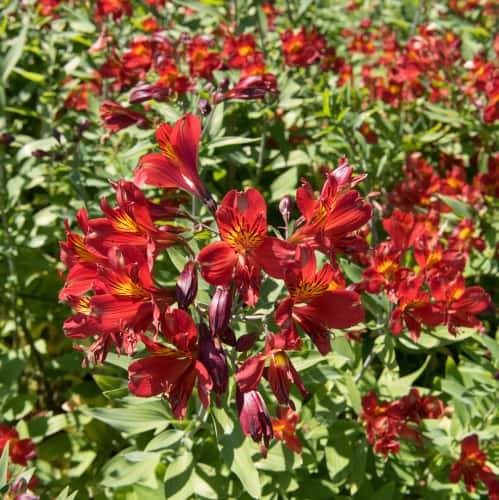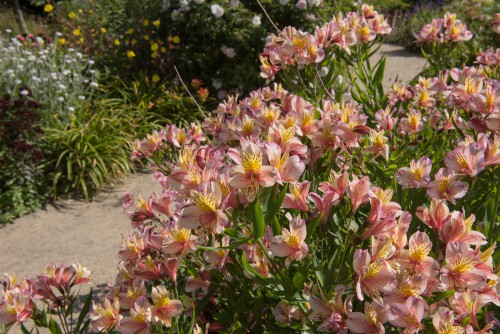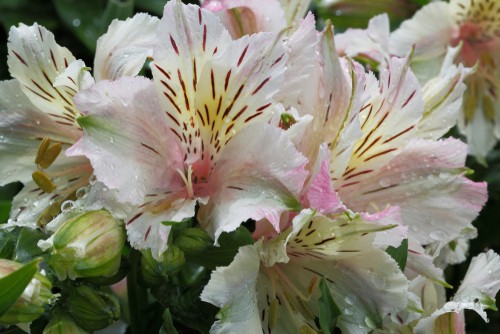Last updated on May 4th, 2022
Our site is reader supported, this means we may earn a small commission from Amazon and other affiliates when you buy through links on our site.
Alstroemerias are tuberous perennials that make wonderful additions to border gardens and, once they are established they can be cut and added to floral arrangements. They are free-flowering and give you a range of colourful flowers from June until the first frosts. Commonly referred to as the Peruvian Lily, they reach an ultimate height between 15cm and one metre depending on the variety and a spread between 45cm and 75cm.
They do well in sunny or partially shaded positions and are very easy to cultivate. If they start to flop they can be staked using flowering sticks for extra support.
Planting
Plant them in full sun or partial shade in free-draining soil
You should plant your Alstroemeria in rich and free-draining soil. They grow well in moist soil but prefer soil that is neutral or slightly acidic. If you have trouble growing them you could consider growing them in pots instead, using a John Innes potting compost because it retains moisture, mixed with plenty of grit to aid drainage.
They do best when positioned in full sun but they can tolerate partial shade. It is best that you give them full sun if your goal is to have as many flowers as possible. The bare root tubers can fail to grow if you are planting them in your flowerbeds, in which case it’s better to use a container.

Mulching to protect roots from frost and retain moisture
Once you have planted your Alstroemeria you need to add mulch (about 15cm deep) to protect it from frost for the following two winters after you have originally planted it. After around two years, once they are fully established, the roots should have grown deep enough that they can survive the winter with very little help from you. Mulching in spring also helps to maintain moisture in the soil and suppress weeds.
Care and Maintenance
Watering
In terms of regular care, there’s very little you need to do to maintain Alstroemerias. They are quite a drought-tolerant plant but you will need to water them regularly during periods of drought, especially in summer. This will encourage additional flowering. If you don’t water to an acceptable level during the flowering season, you might not get as many flowers as you could.

Feeding
You can also provide them with a high potash fertiliser (such as tomato feed) on a weekly basis during the growing season. This will help to encourage more flowers but is usually not essential if you have good quality soil.
Cutting the flowers for displays and deadheading
Because the Alstroemeria makes a wonderful addition to cut floral arrangements, you want to cut the flower stalks during the first season to put in your floral arrangements so that the root system is not damaged. After the first season, however, you can simply pull the flowers out at the base and add them to your arrangements.
Once the flowers have faded you can remove the entire flower spike all the way down to the ground level to encourage additional flowering throughout the season. In autumn we recommend cutting back the whole plant to ground level.
Propagating Alstroemeria by division and seed

If you’re going to propagate you have the option of propagating an Alstroemeria ‘Ligtu hybrids’ variety from seed, which you can collect after the seed pods have turned brown, and place them in small containers until they have germinated.
But in most cases, you’re going to propagate by division, especially the hybrid varieties. It’s best to do this in April and you have to be very careful when doing so because the roots are quite fragile and when you lift the plant to divide it, you’ll need to replant it immediately.
See our detailed guide on how to divide Alstroemeria in this post
Pests and Diseases
There are very few problems that face the Alstroemerias. They can suffer from root stem or crown rot caused by Fusarium or pythium. They are also susceptible to certain viruses, which is why it’s imperative that you provide the optimum growing conditions and keep an eye on them throughout the season to make sure that they’re healthy and happy.
Many of these diseases and viruses are problematic because they target plants that are already in some form of distress. If your plant, for example, is underwatered, the susceptibility is much higher than one that is properly watered. So make sure that you care for your plants regularly.
In terms of pests, you really need only look out for slugs and snails, this problem can be sorted with preventative measures set around the perimeter of where you’re going to grow the Alstroemeria early on.


